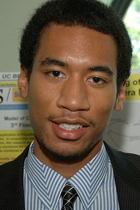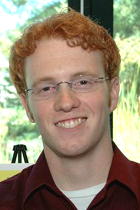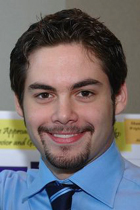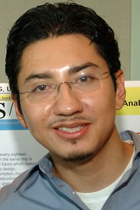|
|
Project Links and Descriptions
| |
|
|

Lana
Carnel
| Locating, isolating and tracking the objects of interest
are a key step in visual scene analysis in surveillance. Reflection,
variations in appearance, clutter, and occlusion create challenges
in identifying the object of interest robustly. Cues (or features)
such as color, motion, size and dynamics must be used in tandem, to
effectively decide what is relevant and discard the unnecessary information
based on the goal at hand. In this work, we look at the target identification
and tracking problem from the point of view of building surveillance
applications and address the aforementioned issues by using multiple
layers of segmentation. The approach involves intelligent feature selection
and robust combination of these features to locate and track these
objects. We demonstrate the results of our implementation on videos
and images taken both in controlled and uncontrolled environments. |
|
 Final
Paper Final
Paper
 Final Poster Final Poster |
|
| |
|
|

Murphy
Gant |
Camera sensor networks are attracting for environment
monitoring and object tracking; however, the main issue is effectively
using the computation power of each camera. This paper investigates
cheap cameras, with some compuation ability of basic information processing
and some communication abilities. Through the functionalities of VisualSense,
a modeling and simulation framework for wireless and sensor networks
that builds and leverages on Ptolemy, one is not just confined to existing
base classes or libraries of subclasses that provide specific channel
and node models, but is open to create their own composite actors and
Java classes for simulation. Algorithms were created to handle such
issues of camera management, visibility, and energy consumption and
this research focused on the simulation of a camera network that monitored
the motion of a single object in a level of Cory Hall. Implementation
of reliable camera management techniques through the use of dual-staged
state machines and intuitive procedures reinforced proposed solutions;
however, there were tradeoff factors such as between communication
and power consumption that were associated with trying to minimize
or maximize certain elements of the system. Although this research
was based on the limited processing capabilities of camera sensors,
new insights into developing more formidable camera sensors would provide
a springboard towards other advancements. Ultimately, regardless of
any stance taken towards enhancing the capabilities of modeling camera
sensor networks, the well-anchored framework of VisualSense supports
most. |
|
 Final
Paper Final
Paper
 Final Poster Final Poster |
|
| |
|
|

Bobby
Gregg |
Because the complexity of bipedal walking robots doubles
when increasing a model's dimensions from two to three, many previously
established analytical techniques are computably impractical for three-dimensional
models. If bipedal walkers can be analyzed in three dimensions, we
can more accurately reproduce the humanoid walking that we observe
in our three-dimensional world. This paper offers a systematic approach
to reducing a 3D biped model into two dimensions, on which 2D analytical
methods can be used, such as numerical analysis to find the limit cycles
that result in asymptotically stable walking. The hybrid reduction
consists of five stages: hybridization of the robot's motion, Lagrangian
formulation of the continuous dynamics, formulation of the discrete
impact transition map, dependency simplification, and the Lagrangian
reduction. We present the results of this method's application on a
simple compass-gait biped using a fixed angle simplification and Routhian
reduction. We show that the reduced model is related to the analogous
2D model by a computable augmented potential component. The model is
easily brought back into 3D using the Routhian relation and can be
implemented in a simulation for analysis. Moreover, we provide supporting
evidence for periodicity in the reconstructed 3D model given periodicity
in the reduced 2D model. The outcome of this paper is a general framework
by which previously established techniques can be applied to three-dimensional
biped models.
|
|
 Final
Paper Final
Paper
 Final Poster Final Poster |
|
| |
|
|

Shams
Karimkhan |
In nature objects are time-dependent and with time they
change in shape, position and composition. System engineering describes
these phenomena with mathematical models. In this project we will use
MATLAB to model and simulate Hybrid Systems (HS). A HS models a discrete
program with an analog environment. The analog part is described by
an ordinary differential equation (ODE). In order to know how the system
works we need to find the solution to the ODE. Due to the fact that
it is almost impossible to find the exact solution we need to use numerical
approximation. By doing this we introduce some uncertainty, or rather
some errors. The next step is controlling the errors, i.e. refining
the simulations, in order to make sure that the simulated solution
will have the same "shape" (behavior, evolution) of the actual
simulation. This idea will be possibly embedded in the currently available
simulation tools for HS. A TCP will be modeled as a HS and the Zeno
behavior will be studied as well as error handling.
|
|
 Final
Paper Final
Paper
 Final Poster Final Poster |
|
| |
|
|

Simon
Ng |
The goal of this project is to simulate a bipedal walker
that walks down a slight slope without any power. We would like to
make a bipedal walker that allows continuous dynamics to be interrupted
by discrete time events. We will use existing equations from past papers
as well as reduplicate dynamics given by Aaron Ames and Bobby Gregg.
We will use a software called HyVisual. An analysis of how this was
implemented in HyVisual as well as how the graphics were animated in
Ptolemy. The results of using these tools will be a bipedal walker
where one can expand the model in the future.
|
|
 Final
Paper Final
Paper
 Final Poster Final Poster |
|
| |
|
|

Reinaldo
Romero |
The complexity of hardware platforms doubles every eighteen
months. The number of processing elements on the same chip is going
to be of
the order of hundreds in the near future which makes the
communication infrastructure very difficult to design. Constraints, especially
in terms of power consumption, must be taken into account and the communication
infrastructure has to be highly optimized. The optimization of a network gives
different results depending on the trade-off between communication and computation.
In this work we derive an expression for such trade-off and we predict how future
communication topologies will look like by analyzing on-chip networks using simple
analytical models.
|
|
 Final
Paper Final
Paper
 Final Poster Final Poster |
|
Downloads
|
To modify this page, use CVS.
For website or program issues contact Dr.
Jonathan Sprinkle.
|



